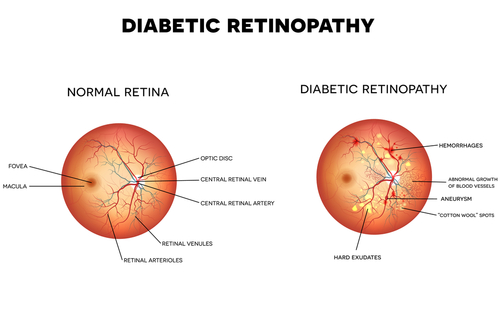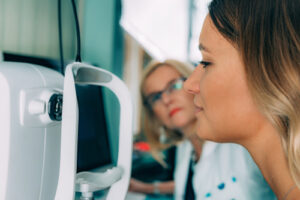Diabetes is a disease that can do severe damage to many parts of your body. Your eyes are no exception. They are particularly susceptible to debilitating conditions.
Because of this sensitivity, diabetes can impact them more negatively than other parts of your body. Conditions caused by diabetes can severely damage your eyes and cause permanent vision loss.
Diabetic retinopathy (DR), non-proliferative diabetic retinopathy (NPDR), diabetic cataracts, and diabetic macular edema are all serious threats to your eyesight.
Without medical intervention and rigorous maintenance, these conditions can take away your vision. The eye doctors at Evergreen Eye Center have the experience and knowledge to prevent vision loss from diabetes.
Diabetic Retinopathy

Diabetic retinopathy is an eye condition that is a complication of diabetes. It occurs as a result of damage to the blood vessels in your retina.
Your retina is a photosensitive sheet at the back of your eye. Light gets focused on it by your cornea and lens, and then the retina sends that light to your brain in the form of nerve signals.
These signals get sent down your optic nerve and then interpreted by your brain, which creates images. Without a healthy retina, you have impaired vision.
DR happens when the blood vessels in your retina get damaged by high blood sugar levels. High blood sugar can cause blocks in these tiny vessels.
The blocks can cause fluid to leak into your vitreous, the gel-like substance that gives your eyes their shape. This leaking can cause blurry or distorted vision.
Also, when they get blocked, your body may try to grow new blood vessels to replace them. These new blood vessels are weak and also break, resulting in more distorted vision.
Symptoms of DR include:
- Floaters
- Dark spots in your field of vision
- Blurred vision
- Fluctuating vision
- Vision loss
If new blood vessels are growing in your eyes, you have proliferative or advanced diabetic retinopathy. Proliferative diabetic retinopathy is a more severe condition than standard, non-proliferative DR.
When it first develops, diabetic retinopathy may not have any symptoms. But, if it develops for long enough, it can cause complete and permanent vision loss.
Non-Proliferative Diabetic Retinopathy
Non-proliferative diabetic retinopathy, or NPDR, is the early stage of DR and the most common. It is when high blood sugar causes blocks in the blood vessels in your retinas.
NPDR can cause the common visual symptoms associated with DR. It also causes blocks and malformed blood vessels.
As the vessels clog, they may expand and distort into unnatural shapes. Also, NPDR can lead to macular edema, where fluid builds up in the center of your retina, called the macula.
Macular edema can lead to vision loss without proper treatment. Maintaining healthy blood sugar levels is the best way to ensure that DR doesn’t lead to vision loss or advanced diabetic retinopathy.
Diabetic Macular Edema
Macular edema is when fluid builds up in your macula or the center of your retina. This buildup can happen naturally on its own, but it’s also a side effect of having diabetic retinopathy.
As the blood vessels in your retina clog and expand due to high blood sugar, they may start leaking fluid. This leaking fluid can gather in your macula, which affects your vision.
Your macula handles your clear, focused, near sight. It helps you recognize faces, read text, and see clearly and sharply in front of you.
As the fluid builds in your macula, it begins to swell, which distorts your vision. Blurry or spotty vision and the inability to recognize faces are common with macular edema.
The best way to prevent diabetic macular edema is to keep your blood sugar low. The lower your blood sugar is, the less stress and pressure you put on the blood vessels in your retinas.
That means there is less clogging leading to less leaking fluid. Less leaking means less fluid builds up in your macula.
Diabetic Cataracts

Cataracts are a clouding of the natural lens in your eye. Usually, they occur as you age, but diabetes can also cause them to form and speeds up their development.
They develop as the proteins in your natural lenses break down and clump together. As cataracts continue to grow, they make your lens whiter and cloudier.
Eventually, this cloudiness blocks light from reaching your retina, and vision loss results. Cataracts may not be preventable, but you can slow their progression if you have diabetes.
Regulating your blood sugar and keeping it below dangerous thresholds is the best thing you can do. Excess sugar in your blood can speed up the process of cataract development.
Fortunately, cataract surgery is the most common medical procedure in the country. Cataract surgery replaces your cloudy natural lens with a replacement lens called an intraocular lens or IOL.
IOLs give you your eyesight back. Depending on how good your vision was before cataracts, IOLs could give you the best sight of your life.
You can still get cataract surgery if you have diabetes. But, since you have diabetes, you need to be extra cautious when preparing for a medical procedure.
Be sure to get plenty of rest before and after your procedure and maintain healthy blood sugar levels the whole time. This will help your recovery and make it easier for you to get back to your everyday life.
How Do You Treat Diabetic Eye Conditions?
Diabetes can wreak havoc on your body. Without controlling your blood sugar, you risk developing other severe conditions.
Many complications of diabetes can damage your eyes and cause permanent vision loss. The best way to prevent this damage is to maintain healthy blood sugar.
You should also see your eye doctor at least twice a year. That way, they can track your eye health and watch for conditions as your diabetes progresses.

If problems are developing, they can intervene with rapid treatment. Standard tests used to diagnose diabetes-related eye conditions include:
- Optical coherence tomography
- Fluorescein angiography
- ICG
- Digital fundus photography
Diabetes is a powerful disease that can have a severe impact on your eyes. We use all available tests to understand what is happening in your eyes.
There are also state-of-the-art treatments that can help you keep your eyesight. One technology is argon lasers.
They can precisely treat various diabetic eye diseases that cause fluid to leak into your eyes. Another treatment, especially for DR, is anti-VEGF therapy.
These medications prevent the growth of new blood vessels in your eyes. If you have DR, anti-VEGF therapy can prevent the proliferation of blood vessel growth.

This prevention means fewer weak blood vessels in your eyes. Fewer fragile blood vessels reduce the amount of fluid in your macula and vitreous.
Photodynamic therapy can also inhibit this growth. During this treatment, medicine gets injected into your arm and travels to your eye.
Once it’s in your eye, your eye doctor shines a light on it, activating the medicine. The medicine seals the blood vessels to stop the leaking.
Do you have diabetes and need to have your eyes checked? Schedule an appointment at Evergreen Eye Center in Seattle, Burien, Federal Way. Tacoma or Auburn, WA, to ensure diabetes will not take your eyesight!

